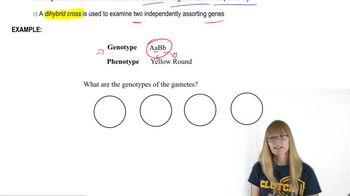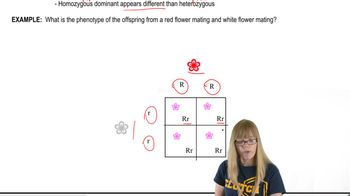Here are the essential concepts you must grasp in order to answer the question correctly.
Independent Assortment
Independent assortment is a fundamental principle of genetics stating that alleles for different genes segregate independently of one another during gamete formation. This means that the inheritance of one trait will not affect the inheritance of another trait, allowing for a variety of combinations in offspring. In the context of the question, it implies that the genes A, B, and C will assort independently when determining the phenotypes of the F₁ and F₂ generations.
Recommended video:
Gamete Genetics and Independent Assortment
Homozygous and Heterozygous
Homozygous refers to an organism having two identical alleles for a particular gene, while heterozygous means having two different alleles. In the given cross, the parental plants are homozygous for their respective traits (AABBCC and AAbbCC), which will influence the genotypes of the F₁ generation. Understanding these terms is crucial for predicting the genetic makeup and resulting phenotypes in subsequent generations.
Recommended video:
Phenotypic Ratios
Phenotypic ratios describe the relative frequencies of different phenotypes in the offspring resulting from a genetic cross. In this scenario, analyzing the F₁ and F₂ generations will involve calculating the expected ratios of flower colors based on the combinations of alleles inherited from the parents. This concept is essential for interpreting the results of the genetic cross and understanding how the mutations affect the biochemical pathway for flower color.
Recommended video:
 Verified step by step guidance
Verified step by step guidance Verified video answer for a similar problem:
Verified video answer for a similar problem:



 4:58m
4:58m